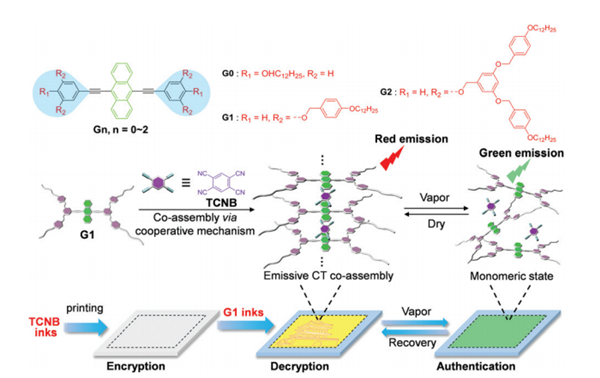The research work on "Receptor-Induced Cooperative Supramolecular Co-assembly with Charge Transfer Properties" has been published online in Chemical Communications
The supramolecular co-assembly of donor (D) and acceptor (A) molecules at specific spatial positions provides an effective and versatile strategy for exploring the applications of π functional materials in areas such as optoelectronics, bioimaging, and information security. Compared to single-component systems, the dual-component D-A co-assembly exhibits synergistic and collective effects, resulting in novel photochemical and photophysical properties. Charge transfer (CT) is a unique property of D-A co-assembly, but due to electron delocalization, the CT process is often accompanied by non-radiative deactivation, which significantly limits photon emission and leads to fluorescence quenching. Therefore, there are few reports on highly emissive supramolecular CT co-assemblies. Furthermore, supramolecular CT co-assemblies with reversible fluorescent switches have been rarely developed, but they have attracted considerable attention for their potential applications in optical computing, anti-counterfeiting, and encryption.
Recently, the research group reported a novel CT-type supramolecular co-assembly with gas-induced fluorescence coloration. They designed and synthesized a series of anthracene-based dendritic supramolecular monomers as electron donors, using 1,2,4,5-tetracyanobenzene (TCNB) as the electron acceptor. Among them, the first-generation dendritic molecule and TCNB co-assembled into supramolecular co-assemblies with a cooperative polymerization mechanism driven by intermolecular π-π stacking, van der Waals forces, and D-A interactions. Due to the dynamic nature of the supramolecular co-assemblies, their fluorescence signals could be reversibly modulated by exposure to chlorinated solvent vapor, demonstrating excellent gas-induced fluorescence coloration properties. Furthermore, the research group successfully fabricated advanced encryption patterns with inkjet printing technology, which possessed encryption and authentication functions. These research findings provide new insights into advanced information protection technologies with high security.

The related research findings have been published in "Chemical Communications" (DOI: 10.1039/D0CC03901B).
(Paper link: https://doi.org/10.1039/D0CC03901B) Associate Professor Zhao Gao is the
first author of the paper, and Professor Wei Tian is the corresponding author.